After checking-out from Taenoyu Onsen, we departed for Aizu-Wakamatsu for the sole purpose of getting on the steam locomotive SL Banetsu Monogatari-go to Niigata; which will be in my next post. From Tazawako Station, we went to Sendai before going to Koriyama. There, we hopped on the Rapid Train on JR Banetsu Saisen (West line) - fully covered by JR East Pass; for about an hour to Aizu-Wakamatsu. Koriyama Station is 1 Hour and 20 Minutes from Tokyo Station by the JR Tohoku Shinkansen Line.
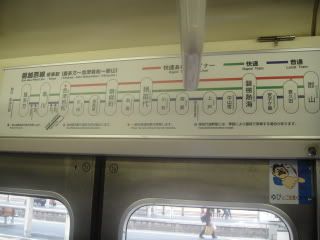

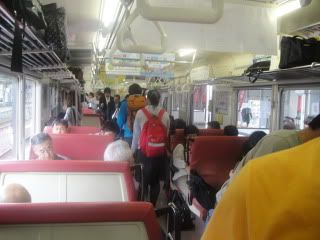 Taking the rapid train to Aizu-Wakamatsu on the Banetsu Saisen. Rapid trains have fewer stops than a local train making the journey much faster. This train however, doesn't run that often, just one every hour so it was quite full by the time it was time to start the journey. Not that it matters much because...
Taking the rapid train to Aizu-Wakamatsu on the Banetsu Saisen. Rapid trains have fewer stops than a local train making the journey much faster. This train however, doesn't run that often, just one every hour so it was quite full by the time it was time to start the journey. Not that it matters much because...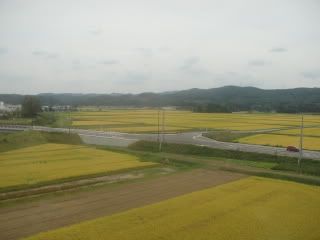
 it was a scenic route getting to our destination. Rows and rows of yellow paddy fields. Of mountains and valleys. Lovely... Although we had to stand for the almost one hour journey, it went by quickly with such a lovely view. Luckily we managed to get Raimie a seat so he spent that whole journey playing with Zaini's Nintendo DS Lite. Raimie's newly bought Nintendo DSi were safely stashed away in our backpack.
it was a scenic route getting to our destination. Rows and rows of yellow paddy fields. Of mountains and valleys. Lovely... Although we had to stand for the almost one hour journey, it went by quickly with such a lovely view. Luckily we managed to get Raimie a seat so he spent that whole journey playing with Zaini's Nintendo DS Lite. Raimie's newly bought Nintendo DSi were safely stashed away in our backpack. In front of Aizu-Wakamatsu station. We didn't sightsee far from the station as we only have a few hours before our scheduled train ride on the SL Banetsu Monogatari-go.
In front of Aizu-Wakamatsu station. We didn't sightsee far from the station as we only have a few hours before our scheduled train ride on the SL Banetsu Monogatari-go.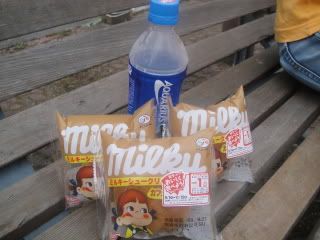 Our simple lunch while waiting for our train eaten at the park nearby.
Our simple lunch while waiting for our train eaten at the park nearby. Raimie with a mechanised Akabeko. Beko, is an Aizu dialect for cow; thus akabeko means red cow. Akabeko is a traditional toy from Aizu. The toy is made from two pieces of lacquered papier-mache, shaped and painted to look like a red cow or ox. One piece represents the cow's head and neck and the other its body. The head and neck hangs from a string and fits into the hollow body. When the toy is moved, the head thus bobs up and down and side to side.
Raimie with a mechanised Akabeko. Beko, is an Aizu dialect for cow; thus akabeko means red cow. Akabeko is a traditional toy from Aizu. The toy is made from two pieces of lacquered papier-mache, shaped and painted to look like a red cow or ox. One piece represents the cow's head and neck and the other its body. The head and neck hangs from a string and fits into the hollow body. When the toy is moved, the head thus bobs up and down and side to side.According to legend, akabeko toys are based on a real cow that lived in AD 807. The townspeople constructed a large temple there dedicated to Buddha and heavy loads of lumber had to be transported long distances using the brute strength of oxen and one of the animals used was a reddish cow. The cow refused to leave the temple grounds after construction had been completed and became a permanent fixture there and became a symbol of zealous devotion to the Buddha.
The earliest akabeko toys were created in the late 16th or early 17th century.There is a believe that the akabeko toys act as amulets against illness. The Akabeko makes a good souvenir, don't you agree?
Another souvenir that you can see in this region was of items with the portrait of Hideyo Noguchi.
He should be a familiar face to those who are familiar with Japanese 1,000yen note. He is a revered Japanese bacteriologist born in 1876 in Inawashiro, Fukushima Prefecture in Japan. He conducted important studies of the causes of syphilis, trachoma, Oroya fever, and yellow fever.
Inawashiro rests on the shores of Lake Inawashiro, one of the largest lakes in Japan. During the Edo period, it was part of the Aizu domain, and was the home of Aizu's secondary castle town.
Just thought you'd like to know a bit of history. :-)
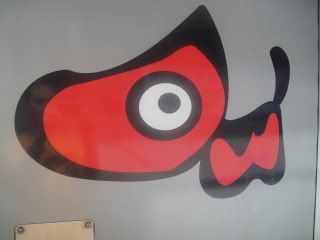


No comments:
Post a Comment